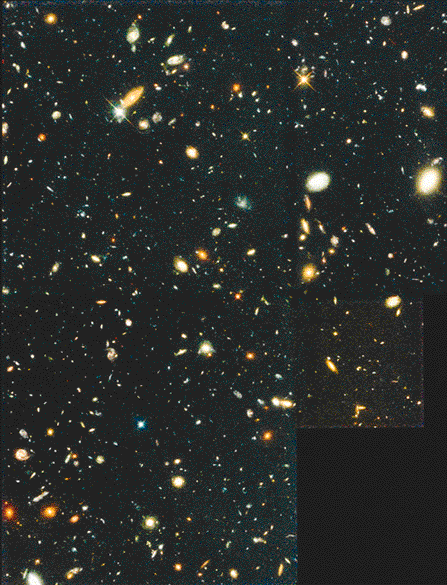

This stunning image takes us far out into space, and far back into time. Known as the Hubble Deep Field, it shows thousands of galaxies of many shapes and colors. By "deep," we mean dim and distant—for this is the faintest photograph ever made; it reaches 30th magnitude, or about four billion times fainter than can be seen by the human eye. To create it, the Hubble Space Telescope exposed its electronic detectors for about a hundred hours, over the course of ten days. Astronomers have likened this photo to a geologist's "core sample" of the Earth's crust; it covers an area only about one one-hundredth of the full Moon. The big ground-based Keck telescope is finding that the small blue shards are among the most distant objects ever seen; perhaps galaxies caught in the act of formation. In all, the image implies that there are about 40 billion galaxies in the observable universe—not far from what astronomers had estimated before the image was taken.
LEARNING GOALS
Studying this chapter will enable you to:
Describe the basic properties of the main types of normal galaxies.
Discuss the distance-measurement techniques that enable astronomers to map the universe beyond the Milky Way.
Summarize what is known about the large-scale distribution of galaxies in the universe.
Describe some of the methods used to determine the masses of distant galaxies.
Explain why astronomers think that most of the matter in the universe is invisible.
Discuss some theories of how galaxies form and evolve.
State Hubble's law and explain how it is used to derive distances to the most remote objects in the observable universe.
Much of our knowledge of the workings of our own Galaxy is based on observations of other galaxies. We know of literally millions of galaxies beyond our own—many smaller than it, some comparable in size, a few much larger. All are vast, gravitationally bound assemblages of stars, gas, dust, dark matter, and radiation, separated from us by almost incomprehensibly large distances. Even a modest-sized galaxy harbors more stars than the number of people who have ever lived on Earth. The light we receive tonight from the most distant galaxies was emitted long before Earth existed. By comparing and classifying the properties of galaxies, astronomers have begun to understand their complex dynamics. By mapping out their distribution in space, astronomers trace out the immense realms of the universe. The galaxies remind us that our position in the universe is no more special than that of a boat adrift at sea.